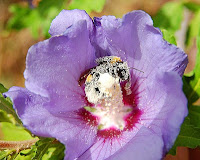 It has made the name of a minor character in a novel by Herman Melville into a household word. It inspired Johann Sebastian Bach to write a cantata. The "it" is coffee, made from the berries of plants of the genus Coffea.
It has made the name of a minor character in a novel by Herman Melville into a household word. It inspired Johann Sebastian Bach to write a cantata. The "it" is coffee, made from the berries of plants of the genus Coffea.Career teachers inevitably accumulate props to enliven their teaching. My middle-school Spanish teacher had one prop that particularly fascinated me. It was a set of five small glass jars demonstrating coffee production, from bright red fruit (simulated) through green beans to ground coffee -- the last being the only form in which most people in the U.S. at that time knew coffee. I was fascinated by the contents of those jars, wanting to know more than the Spanish words. I think I looked at the set closely because I so much wanted to understand this world.
Although cultivated coffee dates back to the 15th century (the plant originating in Ethiopia), the coffeehouse did not develop until the 16th century in Turkey. The first such business in the main part of Europe appeared in the mid 1600's, no more than a century after coffee was introduced there. (Bach's 1735 "coffee cantata" was titled "Be Quiet, Stop Chattering.") Today, half of the adults in the world drink coffee. We of humankind are divided on so many issues, but half of us agree upon liking coffee.
.jpg) |
| Les Deux Magots in Paris today |
Even before counter-cultural beatnik coffeehouses emerged in the 1950's (and even longer before today's widely mainstream Starbucks), there was the tradition of the coffee break: A chance to pause from work. And a chance perhaps to chat with one's co-workers.
To me, all those percolating pots, dripping coffee-makers, and hissing espresso machines speak a message about our Homo sapiens species. They say that we do not live solely by bodily nutrition nor by work alone. If those little red Coffea berries could tell the story of all the experiences they have been through, they would tell us that human beings need a rhythm of work and relaxation, and that we also need conviviality. And to have our minds stimulated.
~~~
Can you think of another plant whose life is intertwined with the lives of human beings?
(The photo of coffee beans is by Marcelo Corrêa
and is used under a Creative Commons Attribution-Share Alike 3.0 Unported license.)

